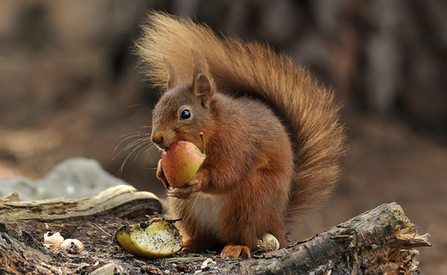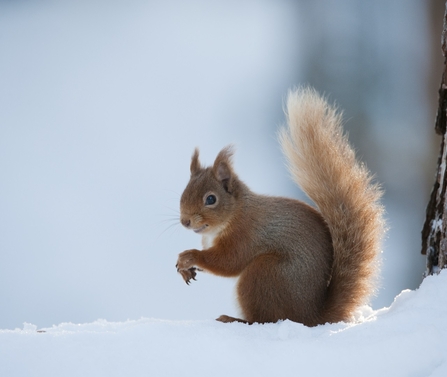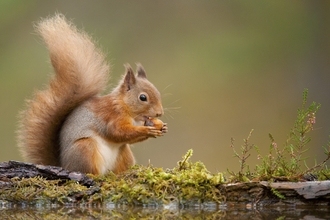The Lancashire, Manchester and North Merseyside Wildlife Trust (LWT) have been granted the go-ahead and funding by The National Lottery Heritage Fund to start a 12 month development phase for the Red Squirrel Recovery Network project, with a view to submitting the final application next year.
The project is a fantastic partner collaboration; involving Northumberland Wildlife Trust (NWT), Cumbria Wildlife Trust (CWT), Knowsley Safari and Southern Uplands Partnership (SUP) in Scotland.

Seeing double; A red squirrel (Sciurus vulgaris)
Photo by Mark Hamblin
The Red Squirrel Recovery Network (RSRN) is an ambitious project which will work at a super-landscape scale to bring about lasting change for red squirrels, who would be lost in 10 years without continuous and extensive conservation effort.
We are at a critical point for the recovery of red squirrels across the UK. For the first time, RSRN will bring together conservation partners and 50+ volunteer groups to work across the Southern Scotland/ Northern England red squirrel range. Due to grey squirrel areas now firmly established to the north and south of this area, and grey squirrel incursion (invasion) occurring regularly, red squirrels in this region are extremely vulnerable to extinction.
What will be delivered?
In the initial development stage (first year) of the project, partners will work together to collect baseline data across the project areas on squirrel distribution, grey squirrel management activity and volunteer demographics to establish the current range of volunteers as well as identify opportunities to encourage new volunteers. Conservation and communication plans will also be developed and emerging science will be built on to support the delivery of grey squirrel fertility control and the annual squirrel Spring Monitoring Programme (Spring Monitoring Programme). Following the development phase, and subject to acceptance from the National Heritage Fund in 2024, the five-year delivery phase will begin. Some of the deliverables throughout the project will include:

Photo by John Bridges
- Building on emerging science to carry out field trials relating to fertility control for grey squirrels and establish new methodologies which are potentially transformative for the future of red squirrels
- For the first time, employing a dedicated Communications Officer to liaise with audiences within and beyond the project area, including responding to volunteer requests to raise awareness, and using new opportunities to build a more resilient supporter base for the red squirrel conservation movement
- Engaging new audiences within the red squirrel range – involving more volunteers to support existing local groups and building a wider network of engaged and aware people in local communities and the general public
- Endearing the beloved red squirrel to new audiences as a way to connect with wildlife; exploring woodlands, noticing nature, developing skills; enabling those in need to feel less isolated, more connected with their community and hopefully see one of our most iconic species in its natural habitat. In particular, providing new targeted activities which will benefit communities in South and East Ayrshire, West Cumbria Coast, South East Northumberland and Knowsley

The Red Squirrel Recovery Network will help establish new income streams for future conservation
Photo by Mark Hamblin
We will also be...
- Working with volunteers and communities in rural areas to understand and monitor the potential impact of pine martens
- Improving data sharing across the area to build a more coherent picture of their current status and likely impact of new game-changing interventions
- Sustaining current conservation efforts, ensuring decades of investment are not lost just at a time when more sustainable approaches are on the horizon
- Providing training, equipment and other support to local groups and volunteers at local, regional and national levels
- Providing small grants for local projects which support local volunteer action (delivered by squirrel groups or other community groups)
- Working with current and new partners to secure a future for reds, and resilient woodlands and forests across the north of England and Southern Scotland – this will include working with partners and landowners to establish new income streams for red squirrel conservation

A smiling squirrel in the snow
Photo by Mark Hamblin
Help us and red squirrels by reporting your sighting here!
Explore more of our conservation work at Lancashire Wildlife Trusts
Our wider work in red squirrel conservation: Frequently Asked Questions and common misconceptions
Read up on red squirrel habitats, identification and behaviours from our species guide here
Enjoy our charming guest blog about when LWT staff reared young red squirrel kittens (2021)







